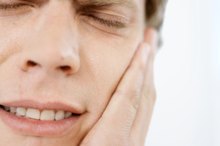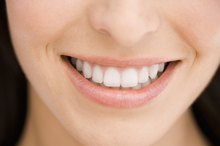Causes of Pain in a Filled Tooth
Many mistakenly believe that getting a filling or crown will prevent a tooth from having problems in the future. Possibilities for a toothache to develop years after receiving dental treatment exist because of the anatomical complexities of a tooth and its surrounding structures. A knowledge of the possible causes of pain can help prevent panic when a toothache develops.
Inflamed Pulp
The dental pulp is the soft tissue on the inside of a tooth. It contains tiny blood vessels, nerve fibers and lymphatic vessels. Pulp tissue has no function in fully developed permanent teeth, but it does become mildly inflamed any time a tooth receives dental treatment. Every tooth that has a filling or crown is susceptible to this mild inflammation becoming more severe. The condition can occur immediately after dental treatment as an acute pulpitis or years later as a chronic pulpitis. The condition can cause a severe toothache, and must be treated with a root canal treatment to save the tooth and alleviate the pain.
- The dental pulp is the soft tissue on the inside of a tooth.
- The condition can cause a severe toothache, and must be treated with a root canal treatment to save the tooth and alleviate the pain.
Infected Pulp
Tooth Pain and Sweets
Learn More
A severely inflamed pulp may never cause enough pain to necessitate treatment. However, this inflammation will cause the pulp to become necrotic, or dead, according to the American Academy of Family Physicians 1. The necrotic tissue will eventually lead to an infection, commonly referred to as an abscessed tooth. Swelling of the gum around a tooth might accompany this condition. An infected pulp results in pain during chewing. Removing a tooth because of severe infection instead of saving it with root canal therapy is rare.
- A severely inflamed pulp may never cause enough pain to necessitate treatment.
- However, this inflammation will cause the pulp to become necrotic, or dead, according to the American Academy of Family Physicians 1.
Hairline Crack
Large fillings on the top and sides of a tooth are notorious for causing hairline cracks to develop, according to the American Dental Association. These cracks can cause a tooth to be sensitive to hot and cold foods and drinks. The classic symptom of a cracked tooth is pain upon biting. Dentists can treat some cracked teeth with a crown, while others require a root canal, according to the American Association of Endodontists 2. Tooth removal is necessary when the crack is so extensive that it leads to an untreatable fractured root.
- Large fillings on the top and sides of a tooth are notorious for causing hairline cracks to develop, according to the American Dental Association.
Traumatic Injury
Abscessed Tooth Years After a Root Canal & Crown
Learn More
A filling or crown does not protect the pulp of a bumped or hit tooth. Pain may develop quickly after the injury or slowly many years later. The result could be an inflamed or infected pulp that produces mild to severe pain, according to the University Of Iowa College Of Dentistry 3. Appropriately treating the pulp is necessary. Trauma may also cause dissolving of the hard internal surface of the tooth, which is known as internal resorption. This condition can cause pain, and requires immediate treatment to save the tooth from extraction.
- A filling or crown does not protect the pulp of a bumped or hit tooth.
- This condition can cause pain, and requires immediate treatment to save the tooth from extraction.
Periodontal Disease
Periodontal or gum disease means a pocket has formed in the gum surrounding a tooth. Seldom does it cause a severe toothache. However, delaying treatment can lead to an inflamed pulp and cause tooth pain.
- Periodontal or gum disease means a pocket has formed in the gum surrounding a tooth.
- However, delaying treatment can lead to an inflamed pulp and cause tooth pain.
Related Articles
References
- American Academy of Family Physicians: Common Dental Emergencies
- University of Iowa College of Dentistry: Saving Teeth Through Root Canal Treatment
- Renton T. Dental (Odontogenic) Pain. Rev Pain. 2011;5(1):2-7. doi:10.1177/204946371100500102
- Lin M, Genin GM, Xu F, Lu T. Thermal Pain in Teeth: Electrophysiology Governed by Thermomechanics. Appl Mech Rev. 2014;66(3):0308011-3080114. doi:10.1115/1.4026912
- Rajeswari K, Kandaswamy D, Karthick S. Endodontic management of patients with systemic complications. J Pharm Bioallied Sci. 2016;8(Suppl 1):S32-S35. doi:10.4103/0975-7406.191962
- Markowitz K, Moynihan M, Liu M, Kim S. Biologic properties of eugenol and zinc oxide-eugenol. A clinically oriented review. Oral Surg Oral Med Oral Pathol. 1992;73(6):729-37.
- Hersh EV, Ciancio SG, Kuperstein AS, et al. An evaluation of 10 percent and 20 percent benzocaine gels in patients with acute toothaches: efficacy, tolerability and compliance with label dose administration directions. J Am Dent Assoc. 2013;144(5):517-26.
- Bei M. Molecular genetics of tooth development. Curr Opin Genet Dev. 2009;19(5):504-10. doi:10.1016/j.gde.2009.09.002
- Hasan S, Singh K, Salati N. Cracked tooth syndrome: Overview of literature. Int J Appl Basic Med Res. 2015;5(3):164-8. doi:10.4103/2229-516X.165376
- American Dental Association. The American Dental Association. Do You Have a Cracked Tooth?
Writer Bio
Dr. Steve Tuggle has been writing dental, health, fitness and wellness articles since 2007. He has been published in the “Journal of Endodontics” and is the author of “The Relaxed Root Canal” ebook. He completed his dental degree and endodontic residency at the Medical College of Georgia School of Dentistry.









